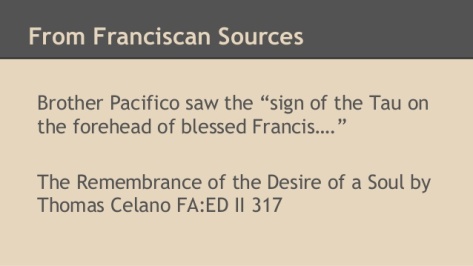Do Secular Franciscans wear a habit?
Yes, Secular Franciscans do wear a habit,
and we always have!
“Another ‘Franciscan’ detail included in the Rule of Nicholas IV concerns the color of the habit. The Memoriale made no mention of it, but the Rule of 1289 stipulates that it be neither ‘all black nor all white.’ That is gray.”*
 As far back as at least just prior to 1289, Secular Franciscans wore habits – the style likely similar to that worn by the religious members of the Franciscan family.
As far back as at least just prior to 1289, Secular Franciscans wore habits – the style likely similar to that worn by the religious members of the Franciscan family.
Up until 1508, Secular Franciscans wore full habits. Then this changed to a large scapular held together by a piece of rope around the waist. Over time, the scapular became smaller until the rope was no longer needed to hold it in place and was replaced by a string, and both were then worn underneath clothing.
As the centuries advanced, and times changed, the ability to wear a “habit of Francis” was not possible for many people in their secular workplace – imagine a fireman or construction worker in a friar’s habit! To enable the seculars to maintain their religious habit in the everyday world, changes were made over the years. 
With the revision of our Rule in 1978, the approved habit on the USA changed from the small scapular and string to the Tau cross.It is most often found in a wooden form, with a knotted cord. The three knots symbolize the religious solemn vows of Poverty, Chastity and Obedience. Seculars do not make vows, but promise to live Gospel to Life and Life to Gospel practicing the secular version of Poverty, Chastity and Obedience: Simplicity, Fidelity and Charity.
The three knots symbolize the religious solemn vows of Poverty, Chastity and Obedience. Seculars do not make vows, but promise to live Gospel to Life and Life to Gospel practicing the secular version of Poverty, Chastity and Obedience: Simplicity, Fidelity and Charity.
But Why The TAU?
The first recorded reference to the TAU is from Ezekiel 9:4, “Go through the city of Jerusalem and put a TAU on the foreheads of those who grieve and lament over all the detestable things that are done in it.” The TAU is the last letter of the Hebrew alphabet and looks very much like the letter “T”.
At the Fourth Lateran Council, on November 11, 1215, Pope Innocent made reference to the TAU and quoted the above verse in reference to the profaning of the Holy Places by the Saracens. It is widely accepted that St. Francis was present at the Fourth Lateran Council and that he heard the words of Pope Innocent III when he said, “The TAU has exactly the same form as the Cross on which our Lord was crucified on Calvary, and only those will be marked with this sign and will obtain mercy who have mortified their flesh and conformed their life to that of the Crucified Savior. From then on, the TAU became Francis’ own coat of arms. Francis used the TAU in his writings, painted in on the walls and doors of the places where he stayed, and used it as his only signature on his writings.
“The TAU has exactly the same form as the Cross on which our Lord was crucified on Calvary, and only those will be marked with this sign and will obtain mercy who have mortified their flesh and conformed their life to that of the Crucified Savior. From then on, the TAU became Francis’ own coat of arms. Francis used the TAU in his writings, painted in on the walls and doors of the places where he stayed, and used it as his only signature on his writings.
St. Bonaventure said, “This TAU symbol had all the veneration and all the devotion of the saint: he spoke of it often in order to recommend it, and he traced it on himself before beginning each of his actions.” Celano, another Franciscan historian writes, “Francis preferred the Tau above all other symbols: he utilized it as his only signature for his letters, and he painted the image of it on the walls of all the places in which he stayed.”
“Francis preferred the Tau above all other symbols: he utilized it as his only signature for his letters, and he painted the image of it on the walls of all the places in which he stayed.”
In the famous blessing of Brother Leo, Francis wrote on parchment, “May the Lord bless you and keep you! May the Lord show His face to you and be merciful to you! May the Lord lift up His countenance upon you and give you peace! God bless you Brother Leo!” Francis sketched a head (of Brother Leo) and then drew the TAU over this portrait.
Due, no doubt, in large part to Francis’ own affection for and devotion to the TAU, it has been a well recognized and accepted Franciscan symbol among Franciscans of various  denominations and of all orders within those denominations for centuries. It remains so today. The TAU carries with it all of the symbolism of the Cross of Christ as well as Francis’ ideal of life and dream for himself and his followers.
denominations and of all orders within those denominations for centuries. It remains so today. The TAU carries with it all of the symbolism of the Cross of Christ as well as Francis’ ideal of life and dream for himself and his followers.
Click HERE for document from CIOFS regarding the wearing of the HABIT.
* From: A Brief History of the Secular Franciscan Order and its Rules,
by William Wicks, OFS
NB: Most material for this page courtesy of the blog: A Franciscan Cross,
by Ken Norian, TSSF